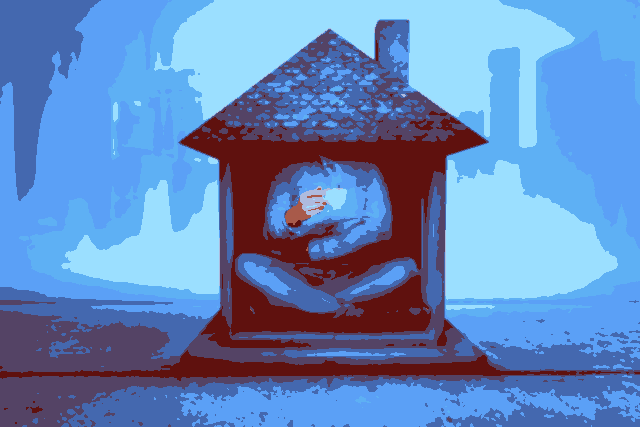
“Not what we have but what we enjoy constitutes our abundance.” ~John Petit-Senn
I love the tiny house movement because it embraces simple living and diminishes the spiritual and financial burdens of materialism. However, I don’t really want to trade in the 1,700 square foot house I love for something that’s 200 square feet!
If you’re like me, you may have felt the same pleasure watching shows like Tiny House Nation, but not known how to apply the ideas they present to life in your larger house.
Well, I’ve found you really can “live tiny” in a not-so-literal way, and reap some of those tiny-living benefits in your bigger home!
Step 1: The ruthless pare-down
First of all, no one transitions to tiny living without trimming down the stuff they possess. I decided I didn’t need a living space reduction to inspire me to undertake an extreme pare-down.
I commenced systematically sorting through everything in my seemingly uncluttered and organized home. (Those qualities were really only on the surface.) I didn’t give a pass to spaces that never got assessed because they seemed fine as-is. I went through my house thoroughly, basement, garage, and gardens included—no drawer, cardboard carton, or crawl space was exempt.
A tiny-living-style purge requires something stricter than the usual “have I used it in the last year?” rule applied with frequent exceptions. For example, of course I hadn’t used my high school prom dress in the last year, but it always got spared in pare-downs due to sentimental value. This time I put the dress on, took a picture, and said goodbye to it.
Here’s a tip regarding clothing reduction: You can easily see how often you use items in your closet by turning hangers to point to the front rather than the back when you wear something. If you find a long time goes by with many pieces on unturned hangers, you’ll see what a small sacrifice it would be to donate them to the needy.
Now don’t be fearful as you purge! This process isn’t nearly the challenge tiny living requires. You have the leeway to take into account how your belongings contribute to your individual quality of life.
Most people have glassware or coffee mugs gathering dust, making them perfect candidates for chucking. Me, I kept a few of every kind of bar glass imaginable—because mixology is one of my passions and I actually use them. But I gave away the eighteen duplicate tools we had between our upstairs tool drawer and our basement tool chest—because you don’t need two drills to be a home handywoman.
The key is simple: As you evaluate each item, ask yourself, Can I have an excellent quality of life without this?
Step 2: Don’t buy new when you can enjoy the old
So, you’ve completed your purge and feel a great weight lifted from your soul. Now the task is to keep things that way! Again, look to the example of the tiny house lifestyle.
I used to love finding a way to justify buying something new—don’t we all? Well, tiny house dwellers don’t have room to expand, so they think twice before making new purchases. And if you do that too, here’s what happens: First, you save a ton of money. Second, you keep your possessions level down. And third, you discover just how great the stuff is that you already have!
Do you even fully know what you already have? I thought I did, but no. I found clothes, décor items, hobby supplies, dishes, etc. that I had forgotten completely but saw had real value. So now I use them! Odds are you too have a ton of possessions that could be a joy to rediscover and use, and it costs nothing.
So, maybe the workhorse old mixer you own isn’t as exciting as a new Kitchenaid, but the money you save by living with it could pay for a month of groceries, a weekend getaway, or fifty eBooks. And why not revert yourself to the wise lifestyle of your grandparents? Mend and repair whenever you can!
In those moments when you used to think, “Oh goody, we could use a new one of these!” ask yourself, Can I have an excellent quality of life without replacing this?
Step 3: One in, one out
So maybe you really do need that new item. You can still adopt the “one in, one out” principle employed by tiny homeowners. They literally have no choice but to make room for new items by removing the old, and that’s the way they keep their belongings at a steady level.
You can discipline yourself to do the same, by finding an unnecessary item to “open a berth” for something new. This is something I’ve traditionally done right before the holidays, to make space for incoming gifts. Even better to apply the principle all the time; you’ll never have to do an extreme pare-down again!
When you bring in the new purchase ask yourself, What can I spare to open up the space for this—who might make far better use of that item than I?
Step 4: Maximize your space
Tiny house dwellers have to get absolutely everything they can out of every square foot of space. They find hidden storage under beds and on the ceiling, and they have brilliantly clever furniture that does double duty as couch/bed or dining table/desk, etc.
Take a good look around your house and make sure you are using all the space you own. (You may even find this inspires you to move to a smaller house!) Your purging could free up a closet that could become a modular home office space. A kitchen can double as a crafting room—I have my crafting materials in rolling storage that I can bring into the kitchen, and the table folds out into a larger size for claying or painting.
One excellent way to gain storage space is by reducing your inventory of books. Keep a small library of special volumes to cherish, of course. Then consider collecting eBooks instead, which take up no physical space at all. Love to read books on paper? They are free at your local library! Or take a tip from Tiny Buddha founder Lori: buy used books and sell them back to the store later (one in, one out).
If you’re short on closet space, look to the challenges met by tiny homeowners. Use an old trunk as a coffee table, under-bed boxes for clothing, and shelving added to vertical spaces. You don’t need to move to a larger home in order to have the space to meet your needs.
Ask yourself, in HGTV parlance, How can I Love It rather than List It?
Step 5: Discover the zen in being minimized and organized
Living tiny in your big house isn’t just about reducing expense and consumption. You’ll be amazed at how following tiny house principles enhances your relationship with your belongings.
Here’s a lesson from our cat toys. Previously we had cat toys in two drawers, two baskets, and four closets—they are now purged, mended, and organized. Now it’s easy to put away stray toys, I know where our stock of new ones is, and I’m not tempted to buy more. And better than that: I’m also more inspired to play with the cats!
In other words, I’m more in tune with my home and all who dwell within it. With distractions reduced, I am more mindful of my environment and how I interact with it. Meanwhile, I don’t miss out on what I already own, and get more enjoyment out of my belongings.
For example, I created a meditation corner with objects incorporating the feng shui elements. I found nearly everything I needed among my current stuff (I did treat myself to a Himalayan salt lamp). Not only do I now have this inspiring, Zen space, but things that were previously hidden away now have a purpose.
Every day or so, find something in your house you haven’t engaged with in a while. Ask yourself gratefully, What is it about this that I really love—and how can I enjoy it even more?
No pain, all gain
If you’re like me and find the tiny house movement really inspiring, the reasons why are clear. Tiny is a great way to live! And in a bigger home, applying these ideas to your lifestyle is all upside. You won’t sacrifice necessary items, space, or privacy. All you give up are things like this:
- Not knowing what you own or where it is
- The stress of clutter and crowding
- Not making full use of your stuff and your space
- Unnecessary consumption and expense
And you gain things like this:
- Sharing your abundance by giving away what you don’t need
- Gratitude for and appreciation of your possessions
- More complete utilization of what you already have
- Increased peace and serenity
So join me in discovering the wonderful aspects of tiny living that we bigger home-dwellers can enjoy. Think tiny…and live large and well!
About Diane Lau
Diane Lau is a multi-published author (also as Diana Laurence), occasional freelance life coach, epicurean, and crafter.













 Though I run this site, it is not mine. It's ours. It's not about me. It's about us. Your stories and your wisdom are just as meaningful as mine.
Though I run this site, it is not mine. It's ours. It's not about me. It's about us. Your stories and your wisdom are just as meaningful as mine. 